How to read the "Thái Bình Hưng Bảo" coins
大平興寶
Phạm Quốc Quân, Vietnam Numismatics #1 (10-2017), p3-4

Most of the books about Vietnamese ancient coins published in Vietnam and abroad mention the "Thái Bình Hưng Bảo [太平興寶]" coin.
These coins were produced during the reign of Đinh Tiên Hoàng.
There are two types of "Thái Bình Hưng Bảo":
- "Thái Bình Hưng Bảo" with the character "Đinh [丁]" on the reverse.
There are four types of the character "Đinh" in different styles and positions.
- "Thái Bình Hưng Bảo" with a plain reverse.
Characters "Thái Bình Hưng Bảo" are written diagonally in clerical or regular script style.
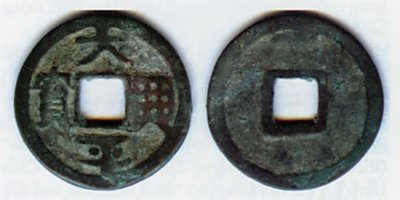
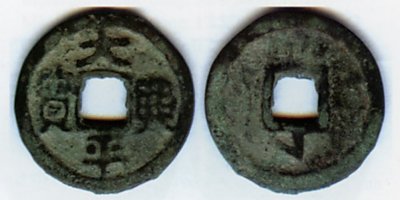
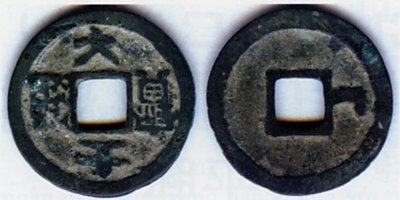
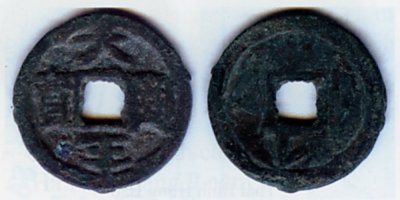
Thus, the coins from the Đinh period exist, though they are relatively simple and scarce.
In this article, I want to discuss the character "Thái [太]". I have examined hundreds of "Thái Bình Hưng Bảo" coins, but there is not a single evidence that it is actually "Thái" rather than "Đại [大]". Perhaps historians, particularly those specializing in ancient coins, have based their identification of this coin as "Thái Bình" on the chronological records: after suppressing the rebellion of the Twelve Warlords, Đinh Bộ Lĩnh founded the Đại Cồ Việt state, proclaimed himself emperor under the name of "Đại Thắng Minh Hoàng Đế", and four years later, in January of the year Canh Ngọ (970), adopted the era name "Thái Bình [太平]". It's interesting that even the earliest records of Đinh-era currency by Hồng Tuân during the Southern Song Dynasty (China) in the book "Tiền chí" affirm the existence of the "Thái Bình Hưng Bảo" coin with detailed descriptions. So what is this coin?
In my opinion, there are several reasons to consider the possibility that there is no "Thái Bình Hưng Bảo" but only "Đại Bình Hưng Bảo", including:
- The writing system does not allow the character "Dai" to be used instead of "Thai". Some argue that the strokes that were on the mold were lost in the process of casting. So, among the hundreds of coins I have seen, shouldn't there be any intact and clear "Thái" characters? In fact, Vietnam also has coins like "Thái An Thông Bảo" and "Thái Hòa Phong Bảo" where the character "Thái" still has clear strokes. Therefore, casting technique cannot explain this phenomenon. There's also an explanation that the character "Thái" was considered taboo as a royal name. In my opinion, this argument is not convincing because, even though there were no rules as strict as those in China, Emperor Thái Tông [Tàizōng, 太宗] of the Northern Song Dynasty (976-983) adopted the era name "Thái Bình Hưng Quốc [Tàipíng Xīngguó, 太平興國]" and issued coins named "Thái Bình Thông Bảo [Tàipíng Tōngbǎo, 太平通寶]"[1].
- In the history of ancient Vietnamese currency, the character "Đại" appears quite frequently. Examples include "Đại Định Thông Bảo [大定通寶]" (Ly Dynasty); "Đại Trị Thông Bảo [大治通寶]", "Đại Trị Nguyên Bảo [大治元寶]", and "Đại Định Thông Bảo [大定通寶]" (Tran Dynasty); "Đại Bảo Thông Bảo [大寶通寶]", "Đại Hòa Thông Bảo [大和通寶]"[2] (Early Le Dynasty); "Đại Chính Thông Bảo [大正通寶]" (Mac Dynasty); "Cảnh Hưng Đại Bảo [景興大寶]" (Le Canh Hung reign), and so on... All the characters "Đại" on the above coins are very clear, despite having various styles. So, why wouldn't there be "Đại Bình Hưng Bảo"?
- The character "Đại" during the Đinh Dynasty is not only found on currency. The bricks excavated in Hoa Lư (Ninh Bình) or the cultural layer from the 10th century in Thăng Long (Hanoi), with the inscription "Đại Việt Quốc Quân Thành Chuyên [大越國軍城塼]" (Great Viet Nation Military Citadel Bricks), provide an interesting suggestion about the connection between the two instances of "Đại".
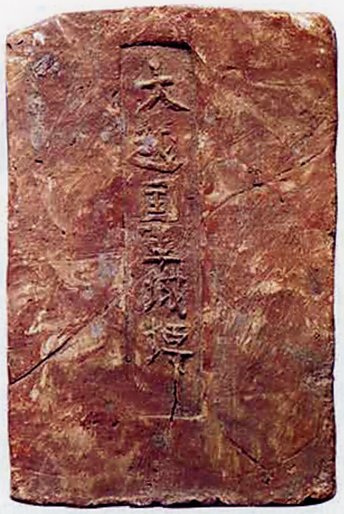
- Speaking of the character "Đại" on the "Thái Bình Hưng Bảo" coins, I'm not the first to bring it up. Bernard J. Premar also read this coin as "Đại Bình Hưng Bảo" since 1963[3], but it seems that not many people have paid attention to this opinion in the study of ancient currency. I would like to share this with you, and I also wish that researchers correctly identify the characters on the coins - something we cannot alter.
(*) Coins from the collection of Mai Ngọc Phát, Hanoi.
[1]
Đỗ Văn Ninh (1992):
Tiền cổ Việt Nam
NXB KHXH, Hanoi, 1992. p. 36.
https://books.google.com/books?id=5oFztAEACAAJ
[2] Mistakenly referenced as "Thái Hòa Thông Bảo [太和通寶]".
[3]
Bernard J. Premar (1963):
Catalogue of Annam Coins, 968-1955.
Khai-Tri, Saigon, 1963.
https://books.google.com/books/?id=5VygswEACAAJ